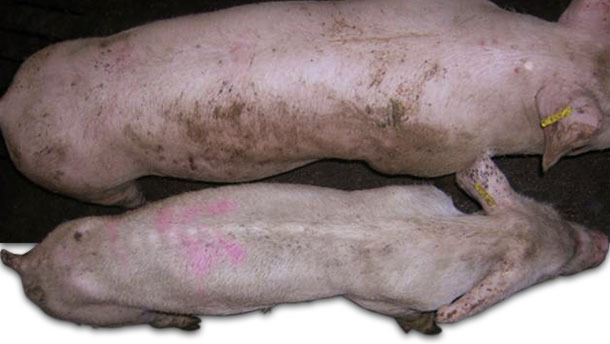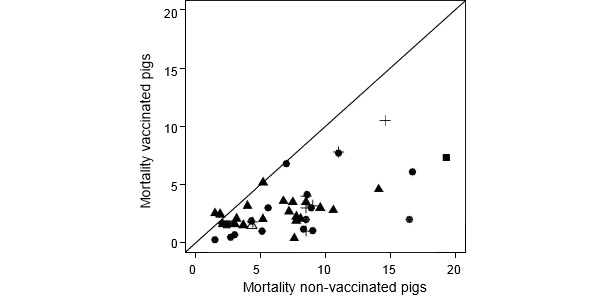Postweaning multisystemic wasting syndrome (PMWS), a condition primarily caused by Porcine circovirus type 2 (PCV2), is considered one of the major swine diseases worldwide. Traditionally, its control was based on counteracting the risk or triggering factors associated to this pathological condition, such as management improvement, control of co-infections and changes of the boar genetic background. However, recently developed PCV2 vaccines have demonstrated to be very efficient to control PMWS and PCV2 infection under experimental and natural conditions. Thus, it has been proven that vaccination of sows and gilts increases PCV2 antibody titres in serum, reduces viremia and viral shedding (milk and colostrum) and improves production parameters (namely decrease of mortality rates and increase of average daily weight gain (ADWG)) of their offspring. Nowadays, there are many commercial vaccines against PCV2 available in the international market; all of them based on PCV2a genotype strains. All are licensed to be applied to growing piglets and only one is also intended for use in both sows and piglets.


PMWS affected animals
Results of several field and experimental trials have shown that PCV2 vaccination of piglets reduces the PMWS impact by means of eliciting humoral (total and neutralizing antibodies) as well as cellular (measured by IFN-γ producing cells) immune responses and reducing and/or delaying PCV2 infection. Moreover, it has been also observed reduction of viral-induced microscopic PMWS-like lymphoid lesions, significantly lesser mortality and cull rates, improvement of ADWG and a decrease in the frequency of co-infections. A comparative field study using the three PCV2 vaccines licensed for use in piglets in United States indicated no significant differences in efficacy among them. Indeed, a meta-analysis study of 66 published field trials found a positive effect of all PCV2 vaccines on pig productivity (increase of average daily gain and the reduction in mortality rates), with no statistically significant differences among some of the currently available commercial PCV2 vaccines (figure 1).

Fig. 1 Paired results on the mortality for non-vaccinated and vaccinated pigs from all trials included in a meta-analysis of the effect of vaccination against PCV2. (Kristensen et al, 2011)
PCV2 vaccine efficacy in piglets has been also demonstrated in presence of maternally derived antibodies (MDA) against PCV2 at the time of vaccination. This latest issue is still under debate. While some authors concluded that no interference between PCV2 antibody titres at vaccination and pig growth does exist, other authors, using different PCV2 vaccine products, supported the existence of MDA interference, at least in regards vaccine-elicited seroconversion. Nowadays, it is generally accepted that vaccine efficacy (measured as average daily gain) was independent from the relatively high level of maternal antibodies present at the time of vaccination and this result could be explained by the fact that PCV2 vaccine efficacy not only depends on the humoral immune response development, but also on the cellular one.
In principle, sow vaccination would homogenize the levels of MDA in piglets, as well as to prevent the likelihood of PCV2 infection in sows. Thus, vaccination of sows with a PCV2 vaccine prior to mating elicited higher and more homogeneous antibody titres in colostrum than the observed in non-vaccinated sows. Moreover, other authors have reported reduced PCV2 shedding in the PCV2 vaccinated sows. This data also suggests that ongoing sow vaccination might ‘stabilise’ serum and colostral antibody titres and potentiate herd immunity. A consequence of such continuous protection would be greater transfer of passive immunity to piglets with attendant enhanced animal health and production as well as reduced infection pressure. Finally, recent research suggests that long-term sow vaccination against PCV2 may improve reproductive parameters. Thus, production parameters such as reproduction rate, number of piglets born alive, birth weight of piglets and number of piglets weaned per a litter improved after implementation of immunization program with a PCV2 vaccine in sows. Moreover, further improvement was observed with vaccination in the following reproduction cycles.
In conclusion, the efficacy of PCV2 vaccines to control PCV2 associated diseases has been clearly demonstrated not only in piglets but also in sows. Moreover, it is also feasible to vaccinate sows and their offspring without hampering its growth during the rearing period.








